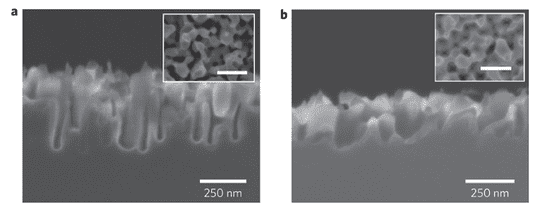In a fantastic breakthrough in solar energy, scientists at the U.S. Department of Energy’s National Renewable Energy Laboratory (NREL) have devised solar cells using nanotechnology which have had a recorded efficiency as high as 18.2%. Now, this alone is far from being deemed impressive, considering the current most efficient solar cells are 35% plus. What makes their research a novel scientific progress is that they managed to attain these figures without using anti-reflective layers, critical to commercial solar panel functionality, but which are extremely expensive. Capitalizing on their findings, a new generation of nano-based solar cells that do not require anti-reflective layers, making them a lot cheaper, might finally make solar energy a force to be reckoned with.

The NREL researchers made a nano-structure surface for their light collecting solar cell, without loosing efficiency. To achieve this, they created nano-islands of silver on a silicon wafer, which was then immersed briefly in liquids to make billions of nano-sized holes in each square-inch of the silicon wafer surface. Since the holes and silicon walls are smaller than the light wavelengths hitting them, the light doesn’t bounce back into the atmosphere as it doesn’t recognize any change in density at the solar cell’s surface – this translates into a significant energy saving.
Typical solar cells currently commercially available employ multiple layers of anti-reflecting materials to achieve the same effect, at a very high financial cost, however. Howard Branz, principal investigator of the research said:
“This work can have a big impact on both conventional and emerging solar cell based on nanowires and nanospheres. For the first time it shows that really great solar cells can be made from nanostructured semiconductors.”
Branz added, “The next challenges are to translate these results to common industrial practice and then get the efficiency over 20%. After that, I hope to see these kinds of nanostructuring techniques used on far thinner cells to use less semiconductor material.”
“Now we have a clear study that shows how optimizing the surface area and the doping together can give better efficiency,” Yuan said. “The surface area and the doping concentration near the surface affect nano-structured solar-cell performance.”
The findings were reported in the journal Nature Nanotechnology.






